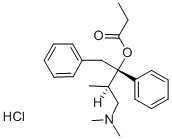COMPUTED DESCRIPTORS
| Molecular Weight | 375.9 g/mol |
|---|---|
| Hydrogen Bond Donor Count | 1 |
| Hydrogen Bond Acceptor Count | 3 |
| Rotatable Bond Count | 9 |
| Exact Mass | 375.1965069 g/mol |
| Monoisotopic Mass | 375.1965069 g/mol |
| Topological Polar Surface Area | 29.5 Ų |
| Heavy Atom Count | 26 |
| Formal Charge | 0 |
| Complexity | 397 |
| Isotope Atom Count | 0 |
| Defined Atom Stereocenter Count | 2 |
| Undefined Atom Stereocenter Count | 0 |
| Defined Bond Stereocenter Count | 0 |
| Undefined Bond Stereocenter Count | 0 |
| Covalently-Bonded Unit Count | 2 |
| Compound Is Canonicalized | Yes |
PRODUCT INTRODUCTION
description
Propoxyphene Hydrochloride is the hydrochloride salt form of the d-isomer of synthetic diphenyl propionate derivative propoxyphene, with narcotic analgesic effect. This agent mimics the effects of the endogenous opiate dextropropoxyphene, by binding to mu receptors located throughout the central nervous system. The binding results in GTP to GDP exchanges on the mu-G-protein complex, by which effector adenylate cyclase is inactivated thereby decreasing intracellular cAMP. This, in turn, inhibits the release of various nociceptive neurotransmitters, such as substance P, gamma-aminobutyric acid (GABA), dopamine, acetylcholine, noradrenaline, vasopressin, and somatostatin. In addition, dextropropoxyphene closes N-type voltage-gated calcium channels and opens calcium-dependent inwardly rectifying potassium channels. This results in hyperpolarization, thereby reducing neuronal excitability, which further decreases the perception of pain.
